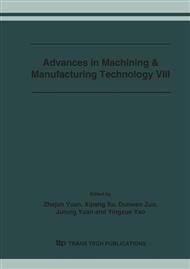p.469
p.474
p.481
p.486
p.491
p.496
p.501
p.507
p.511
Direct Joining of Acrylic Rubber to Cast Iron with Functional Nanofilm by Polymer Plating
Abstract:
The nanoscale functional thin film with the affinity to acrylic rubber was formed on the surface of a high ductile spheroidal-graphite cast iron by means of polymer plating of 6-diallylamino-1,3,5-triazine-2,4-dithiol monosodium salt. The direct joining of acrylic rubber to the cast iron was achieved with the functional nanofilm during curing. High peel strength adherend of the rubber/cast iron was obtained with suitable film thickness and good film quality under curing at 453 K for 18 min. When the film thickness was 8.53 nm, peel strength of the adherend was high to 4.9 kNm-1, and its broken-out section was rubber cohesive failure. The film thickness considerably affected peel strength and rubber coverage. Moreover, the current density of polymer plating had largely influence on mass and quality of thin film, thereby on joining property of acrylic rubber to the cast iron. The good joining property results from chemical bond within interfacial layer of acrylic rubber chain and reactive groups of nanofilm polymer-plated on the surface of cast iron.
Info:
Periodical:
Pages:
491-495
Citation:
Online since:
July 2006
Authors:
Price:
Сopyright:
© 2006 Trans Tech Publications Ltd. All Rights Reserved
Share:
Citation:


